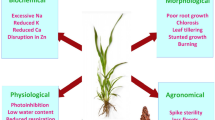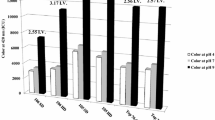Abstract
Sweet sorghum is an outstanding feedstock choice for bioethanol production, but the gap between theoretical and commercial ethanol yields must be reduced to improve economic viability. Extractable juice yield is a primary limiting factor for higher ethanol yield, but current phenotyping techniques to measure juice yield in sorghum can be laborious. Therefore, alternative approaches to measuring juice yield during selection are needed. The objectives of this study were to investigate the relationship between stalk-related traits and juice yield and to assess the ability to predict juice yield using agronomic traits and stalk properties across and within a diverse set of sorghum ideotypes (photoinsensitive, photosensitive, biomass, grain, and sweet types). Stalk weight, stalk volume, stalk diameter, and plant height had significantly strong associations with juice yield, which were consistent across different sorghum ideotypes. The direct and indirect effects of multiple predictive traits on juice yield varied greatly with the distinct sorghum subsets. However, equation modeling demonstrated that juice yield is satisfactorily predicted by jointly assessing stalk weight and stalk moisture. Moreover, alternative prediction models involving distinct combinations of agronomic and stalk-related traits had similarly good prediction accuracy. Altogether, this suggests that several prediction models can be used to accelerate phenotyping for juice yield, which will improve the selection process. Overall, the results indicate that increasing sorghum juice yield via indirect selection is possible, but the choice of prediction model depends on the ideotypes and resources available in a breeding program.





Similar content being viewed by others
References
International Energy Agency (2015) Global energy trends to 2040. Business-as-usual or a brave new world? In: World Energy Outlook 2015. France, p 53–109
Smith GA, Bagby MO, Lewellan RT, Doney DL, Moore PH, Hills FJ, Campbell LG, Hogaboam GJ, Coe GE, Freeman K (1987) Evaluation of sweet sorghum for fermentable sugar production potential. Crop Sci 27(4). doi:10.2135/cropsci1987.0011183X002700040037x
Schaffert R (1992) Sweet sorghum substrate for industrial alcohol. In: Gomez MI, House LR, Rooney LW, Dendy DAV (eds) Utilization of sorghum and millets, vol 502. Patancheru, A. P. 502 324, International Crops Research Institute for the Semi-Arid Tropics, India, p 131–137
Smith GA, Buxton DR (1993) Temperate zone sweet sorghum ethanol production potential. Bioresour Technol 43(1):71–75. doi:10.1016/0960-8524(93)90086-q
Woods J (2001) The potential for energy production using sweet sorghum in southern Africa. Energy for Sustainable Development 5(1):31–38. doi:10.1016/s0973-0826(09)60018-1
Zhang C, Xie G, Li S, Ge L, He T (2010) The productive potentials of sweet sorghum ethanol in China. Appl Energy 87(7):2360–2368. doi:10.1016/j.apenergy.2009.12.017
Davila-Gomez FJ, Chuck-Hernandez C, Perez-Carrillo E, Rooney WL, Serna-Saldivar SO (2011) Evaluation of bioethanol production from five different varieties of sweet and forage sorghums (Sorghum bicolor (L) Moench). Ind Crop Prod 33(3):611–616. doi:10.1016/j.indcrop.2010.12.022
Rutto LK, Xu Y, Brandt M, Ren S, Kering MK (2013) Juice, ethanol, and grain yield potential of five sweet sorghum (Sorghum bicolor [L.] Moench) cultivars. Journal of Sustainable Bioenergy Systems 03(02):113–118. doi:10.4236/jsbs.2013.32016
Zhao YL, Dolat A, Steinberger Y, Wang X, Osman A, Xie GH (2009) Biomass yield and changes in chemical composition of sweet sorghum cultivars grown for biofuel. Field Crop Res 111(1–2):55–64. doi:10.1016/j.fcr.2008.10.006
Yu J, Zhang T, Zhong J, Zhang X, Tan T (2012) Biorefinery of sweet sorghum stem. Biotechnol Adv 30(4):811–816. doi:10.1016/j.biotechadv.2012.01.014
Corn RJ (2009) Heterosis and composition of sweet sorghum. Texas A&M University, College Station
Bull TA, Glasziou KT (1963) The evolutionary significance of sugar accumulation in Saccharum. Aust J Biol Sci 16(4):737–742. doi:10.1071/BI9630737
Grof CPL, Campbell JA (2001) Sugarcane sucrose metabolism: scope for molecular manipulation. Funct Plant Biol 28(1):1. doi:10.1071/pp00039
Jackson PA (2005) Breeding for improved sugar content in sugarcane. Field Crop Res 92(2–3):277–290. doi:10.1016/j.fcr.2005.01.024
Murray SC, Sharma A, Rooney WL, Klein PE, Mullet JE, Mitchell SE, Kresovich S (2008) Genetic improvement of sorghum as a biofuel feedstock: I. QTL for stem sugar and grain nonstructural carbohydrates. Crop Sci 48(6):2165–2179. doi:10.2135/cropsci2008.01.0016
Wu X, Staggenborg S, Propheter JL, Rooney WL, Yu J, Wang D (2010) Features of sweet sorghum juice and their performance in ethanol fermentation. Ind Crop Prod 31(1):164–170. doi:10.1016/j.indcrop.2009.10.006
Swanson AF, Parker JH (1931) Inheritance of smut resistance and juiciness of stalk. The Journal of Heredity 22(2):51–56
Quinby J, Karper R (1954) Inheritance of height in sorghum. Agron J 46(5):211–216
Burks PS, Kaiser CM, Hawkins EM, Brown PJ (2015) Genomewide association for sugar yield in sweet sorghum. Crop Sci 55(5):2138–2148. doi:10.2135/cropsci2015.01.0057
Hart EG, Schertz FK, Peng Y, Syed HN (2001) Genetic mapping of Sorghum bicolor (L.) Moench QTLs that control variation in tillering and other morphological characters. Theor Appl Genet 103(8):1232–1242. doi:10.1007/s001220100582
Mace ES, Jordan DR (2010) Location of major effect genes in sorghum (Sorghum bicolor (L.) Moench). Theor Appl Genet 121(7):1339–1356. doi:10.1007/s00122-010-1392-8
Zou G, Zhai G, Feng Q, Yan S, Wang A, Zhao Q, Shao J, Zhang Z, Zou J, Han B, Tao Y (2012) Identification of QTLs for eight agronomically important traits using an ultra-high-density map based on SNPs generated from high-throughput sequencing in sorghum under contrasting photoperiods. J Exp Bot 63(15):5451–5462. doi:10.1093/jxb/ers205
Shiringani AL, Frisch M, Friedt W (2010) Genetic mapping of QTLs for sugar-related traits in a RIL population of Sorghum bicolor L. Moench Theoretical and Applied Genetics 121(2):323–336. doi:10.1007/s00122-010-1312-y
Calviño M, Messing J (2012) Sweet sorghum as a model system for bioenergy crops. Curr Opin Biotechnol 23(3):323–329. doi:10.1016/j.copbio.2011.12.002
Salas Fernandez MG, Becraft PW, Yin Y, Lübberstedt T (2009) From dwarves to giants? Plant height manipulation for biomass yield. Trends Plant Sci 14(8):454–461. doi:10.1016/j.tplants.2009.06.005
Pfeiffer TW, Bitzer MJ, Toy JJ, Pedersen JF (2010) Heterosis in sweet sorghum and selection of a new sweet sorghum hybrid for use in syrup production in Appalachia. Crop Sci 50(5):1788–1794. doi:10.2135/cropsci2009.09.0475
Gravois KA, Milligan SB, Martin FA (1990) The role of pith, tube, and stalk density in determining sugarcane sucrose content and stalk weight. Theor Appl Genet 79(2):273–277. doi:10.1007/BF00225963
Guan Y, Wang H, Qin L, Zhang H, Yang Y, Gao F, Li R, Wang H (2011) QTL mapping of bio-energy related traits in Sorghum. Euphytica 182(3):431–440. doi:10.1007/s10681-011-0528-5
Felderhoff TJ, Murray SC, Klein PE, Sharma A, Hamblin MT, Kresovich S, Vermerris W, Rooney WL (2012) QTLs for energy-related traits in a sweet × grain sorghum [Sorghum bicolor (L.) Moench] mapping population. Crop Sci 52(5):2040–2049. doi:10.2135/cropsci2011.11.0618
May A, Campanha M, Silva A, Coelho M, Parrella RA, Schaffert RE, Pereira Filho IA (2012) Variedades de sorgo sacarino em diferentes espaçamentos e população de plantas. Revista Brasileira de Milho e Sorgo
May A, de Souza VF, Gravina GA, Fernandes PG (2016) Plant population and row spacing on biomass sorghum yield performance. Ciência Rural 46(3):434–439
Broadhead DM, Freeman KC (1980) Stalk and sugar yield of sweet sorghum as affected by spacing. Agron J 72(3):523–524. doi:10.2134/agronj1980.00021962007200030026x
Worley JW, Cundiff JS, Vaughan DH, Parrish DJ (1991) Influence of sweet sorghum spacing on stalk pith yield. Bioresour Technol 36(2):133–139. doi:10.1016/0960-8524(91)90170-O
Schneider CA, Rasband WS, Eliceiri KW (2012) NIH image to ImageJ: 25 years of image analysis. Nat Methods 9(7):671–675. doi:10.1038/nmeth.2089
Bollen KA (2014) Structural equations with latent variables. Wiley series in probability and mathematical statistics. Wiley
Zou G, Yan S, Zhai G, Zhang Z, Zou J, Tao Y (2011) Genetic variability and correlation of stalk yield-related traits and sugar concentration of stalk juice in a sweet sorghum (Sorghum bicolor L. Moench) population. Aust J Crop Sci 5(10):1232–1238
Makanda I, Tongoona P, Derera J (2009) Quantification of genotypic variability for stem sugar accumulation and associated traits in new sweet sorghum varieties. In: African Crop Science Conference Proceedings, p 391–398
Godoy JGV, Tesso TT (2013) Analysis of juice yield, sugar content, and biomass accumulation in sorghum. Crop Sci 53(4):1288–1297. doi:10.2135/cropsci2012.04.0217
Vasilakoglou I, Dhima K, Karagiannidis N, Gatsis T (2011) Sweet sorghum productivity for biofuels under increased soil salinity and reduced irrigation. Field Crop Res 120(1):38–46. doi:10.1016/j.fcr.2010.08.011
Caravetta GJ, Cherney JH, Johnson KD (1990) Within-row spacing influences on diverse sorghum genotypes: I. Morphology Agron J 82(2):206–210. doi:10.2134/agronj1990.00021962008200020007x
Kang MS, Sosa O, Miller JD (1989) Path analyses for percent fiber, and cane and sugar yield in sugarcane. Crop Sci 29(6):1481–1483. doi:10.2135/cropsci1989.0011183X002900060032x
Bell M, Garside A, Halpin N, Berthelsen J (2004) Interactions between stalk number and stalk weight and the implications for cane yield. In: Proceedings of the Australian Society of Sugar Cane Technologists. PK Editorial Services, p 22–52
Prasad S, Kumar A, Muralikrishna KS (2013) Assessment of ethanol yield associated characters in sweet sorghum. Maydica 58(1–4):299–303
Liu DL, Helyar KR (2003) Simulation of seasonal stalk water content and fresh weight yield of sugarcane. Field Crop Res 82(1):59–73. doi:10.1016/s0378-4290(03)00019-4
Miller J, James N (1974) The influence of stalk density on cane yield. In: Proc. Int. Soc. Sugar Cane Technol. vol 1, p 177–183
Miller JD (1977) Combining ability and yield component analyses in a five-parent diallel cross in sugarcane. Crop Sci 17(4):545–547. doi:10.2135/cropsci1977.0011183X001700040016x
Brown A, Daniels J, Latter B (1969) Quantitative genetics of sugarcane: II. Correlation analysis of continuous characters in relation to hybrid sugarcane breeding. Theor Appl Genet 39(1):1–10
Stephens JC, Quinby JR (1939) The D Rs P linkage group in sorghum. J Agric Res 59(10):725–730
Acknowledgments
The authors are grateful to The National Council for Scientific and Technological Development (CNPq), Brazil, and The Tom Slick Graduate Research Fellowship at Texas A&M University for a Ph.D. fellowship and financial support granted to GC. We also thank Dr. Seth C. Murray and Dr. David Pot for comments that greatly improved the manuscript. This research was partially supported by grants from DOE/USDA BRDI program.
Author information
Authors and Affiliations
Corresponding author
Ethics declarations
Conflict of Interest
The authors declare that they have no conflict of interest.
Electronic Supplementary Material
ESM 1
(DOCX 582 kb)
Rights and permissions
About this article
Cite this article
Carvalho, G., Rooney, W.L. Assessment of Stalk Properties to Predict Juice Yield in Sorghum. Bioenerg. Res. 10, 657–670 (2017). https://doi.org/10.1007/s12155-017-9829-4
Published:
Issue Date:
DOI: https://doi.org/10.1007/s12155-017-9829-4




